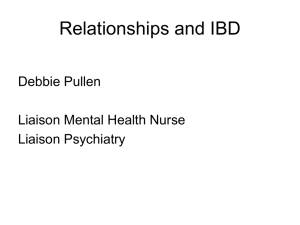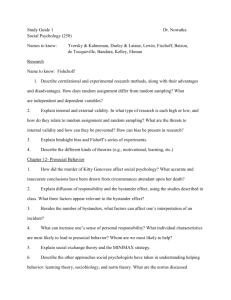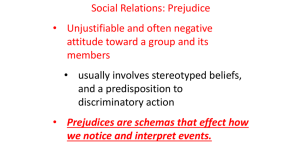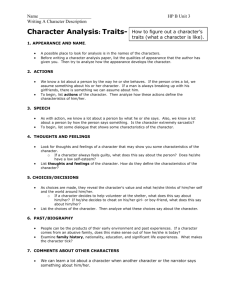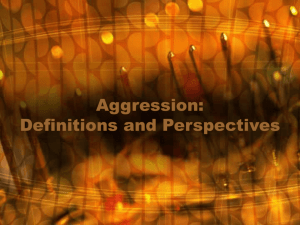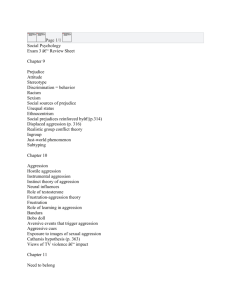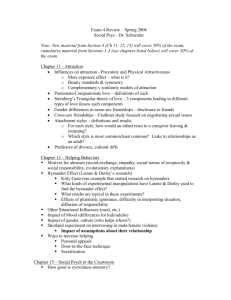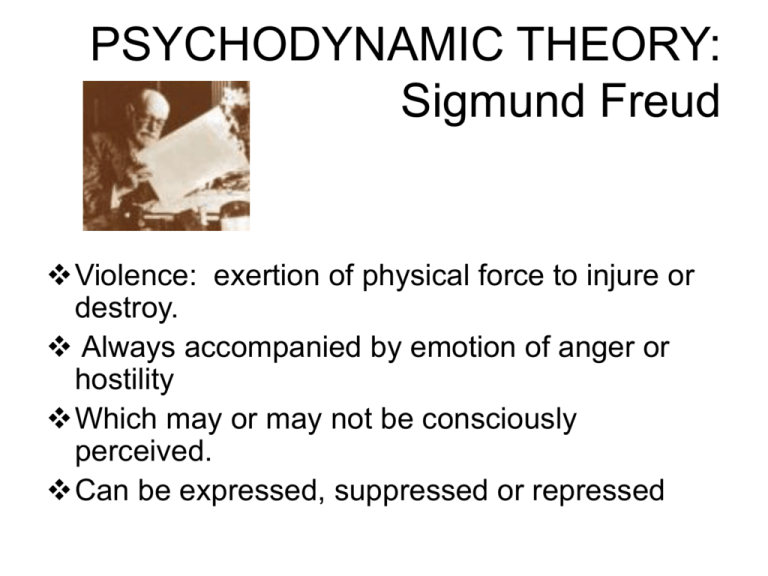
PSYCHODYNAMIC THEORY:
Sigmund Freud
Violence: exertion of physical force to injure or
destroy.
Always accompanied by emotion of anger or
hostility
Which may or may not be consciously
perceived.
Can be expressed, suppressed or repressed
Psychodynamic Theory
• Anger must reach certain intensity before
resulting in violence
• The threshold for violence varies from
individual to individual based upon
biological differences
Psychodynamic Theory
• Violence are instincts or drives
– Drives: implied a state of readiness for
certain types of behavior
– Instincts: implies a set of inborn patterns of
behavior that is complete and autonomic in
response to a given stimulus
Primary Instincts
• Violence is a primary drive:
– Aggressive drives are based upon
– Thanatos: death instinct,
• anti-death wish
– Libidinal: sexual instinct,
• discharging energy
Primary Drives
• Two Subtypes of aggression which result from
primary drives:
– Reactive: reactive and proportional to a frustrating
situation. It's release serves to reduce tension and if
complete permanently discharges the emotion. This
prevents repression.
– Explosive rage: unprovoked and not in proportion
to any event or stimulus. A dangerous form of
primary aggression. Results from a short-circuiting of
this process in lower brain centers (psychotic trigger
syndrome)
•
Psychodynamic Theory
Both of these types of response release the tension.
Blockage
Frustration
Anger
Inflicting pain on
others
(primary aggression)
Pleasure
seeking
New effort
or delay of
gratification
Repression and /or
defense
Secondary Defensive
Aggression
• Secondary (defensive) Aggression: Hostile or violent
behavior that is entirely distortional or even unrelated to
current provocation. "chip on their shoulder", short fuse
This aggression taps on a warehouse of previously
stored hostility. Senseless killings: no apparent
motivation.
Theoretically the release of tension should deplete the
store, but with secondary aggression the
aggressiveness continues to express itself over and
over again in a repetitive compulsive fashion even
when the consequences are disastrous.
Primary Autonomous Ego traits
•
•
•
•
Oral
Anal
Oedipal
Latency
Oral Traits/feelings
• Traits
–
–
–
–
Greed,
insatiability
constant demand for attention
toughness
• Feelings
– Worthlessness
– Vulnerability
– Feelings of deprivation
• Earliest biological and emotional needs are not
met lack of gratification and frustrations
Anal Phase
• Traits
–
–
–
–
Defiant behaviors
Lack of self-control
Impulsive
Lives for the moment, oblivious to future
consequences of their acts
• Feelings
– Hostility
– Fear of own affectionate wishes
– Driving away others
Oedipal Phase
• Traits
– Sexual impulses: rivals and candidates
– Unresolved conflict
– Secondary aggression
• Feelings
– Angry
– Dissatisfied
– Exaggerated fear of castration anxiety
Latency Phase
• Traits
– Peer pressure: we-they thinking
– Alliance to an aggressive group
can create increased aggression
– Father figure
• Strong-silent type, no father present or weak father result
in hostile behavior
• Aggressor: father is cruel tormentor
• Self-concept as a bad person
– Superego “I am bad, ego responds to do bad things
• Cruelty: need to subjugate others, to dominate others



